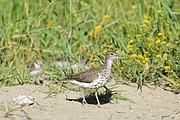The hop, skip and bob of the spotted sandpiper!
Don Bartling Contributing Writer | Hagadone News Network | UPDATED 6 years, 4 months AGO
Last weekend, while traveling along the shoreline of Deep Creek and the Kootenai River, I noticed an unusual bird.
The bird had an olive brown back, long bill and long, dull yellow legs with a white line over his eyes. The bird had black spots on a white chest and belly. The small shorebird, a spotted sandpiper, constantly was bobbing its tail while standing and walking as if delicately balanced while working edges of the water for invertebrates.
The spotted sandpiper is one of the easiest sandpipers to identify. Not only are its markings distinctive, but also its mannerisms — the bird species signals itself to birders by almost constantly bobbing its rear end.
The thrush-like breast of breeding adult spotted sandpipers sets them apart from other sandpipers, but you can also easily identify spotless immatures and non-breeders. For one thing, the spotted sandpiper’s tail and rear end constantly bob up and down as the bird walks or pauses; this is true even in birds that have just left the nest. Also, look for a white crescent on the sides, which curls around the bend of the bird’s folded wing, inching toward the back.
Spotted sandpipers are about 7.5 inches in length and smaller than a robin — in other words, they are not the tiniest sandpipers, but they are rather small. Breeding individuals have bright orange bills; otherwise, spotted sandpipers have pale pinkish or orange bills and legs.
Living on the shores of streams, rivers, ponds and lakes, the spotted sandpiper is one of the most widespread shorebirds in the United States. The sandpiper breeds across most of North America and spends winters on the coastlines of North America or south from Central America to South America.
Spotted sandpipers are active foragers along stream banks and lake edges, walking in meandering paths and suddenly darting at prey — almost constantly bobbing their tail end in a smooth motion. Their flight style is equally distinctive: low over the water with stuttering bursts of fast wingbeats interspersed with very brief glides.
Spotted sandpipers were one of the first bird species described in which the roles of the males and females are reversed. Males are usually smaller, less aggressive and tend the nest and young. Meanwhile, the larger females fight for territories and may be polyandrous, meaning they mate with more than one male. Males that mate with the same female set up smaller territories within her territory and defend them against each other.
The females perform courtship behavior, usually an elaborate swooping flight with the wings held open while the birds gives its weet-weet song. She may also give a strutting courtship display from the ground. Females that are looking for mates over a wide area may do this up and down considerable lengths of shoreline. Interested males remain on the territory while uninterested males are chased away.
Both parents build the nest, a depression in the ground usually sheltered by some plant cover and lined with plants or moss. There the female usually lays four eggs, which may be incubated by the male or by both parents for about three weeks. The nestlings teeter as soon as they hatch and can almost immediately scamper from the nest. Usually the male watches over the young, which can fly when they are about 18 days old.
As would be expected of a bird that frequents a mixture of habitats, the spotted sandpiper captures a variety of prey in diverse ways. Insects, crabs, worms, small fish, and other creatures may be picked from the water or shore, caught in quick flights, or chased and eaten.
Enjoy this summer and Boundary County’s wildlife!
ARTICLES BY DON BARTLING CONTRIBUTING WRITER

About the Douglas fir
“The big tree is nature’s forest masterpiece, and so far as I know, the greatest of living things.” — John Muir 1838-1914 “Father of the National Parks” and author.

Winter on the hoof: How deer, elk and moose cope with the snow!
“When snow falls, nature listens.”




